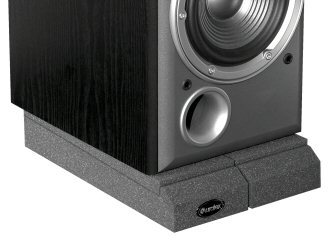I feel a bit daft posting this, but here goes:
A few weeks ago, while browsing audio topics, I came across discussions about and praise of the Townshend Podium (££££), Townshend Seismic Bars (£££ for those in poverty) and the IsoAcoustics Gaia feet (££). They "work" by decoupling the speaker from the floor. (Townshend seem to target the audiophile crew but IsoAcoustics make pro-audio stuff.)
I always thought that metal spikes under loudspeakers were de rigueur but I was curious. Squash balls are cheap so I decided to see what would happen with them.
I removed the spikes and replaced each of them with half a squash ball. The squash balls were ... err ... pretty well squashed but the loudspeakers still wobbled when touched - not excessively though.
Alas I am missing those "golden ears" so usually when I try something out (e.g. interconnect leads) I often (not not always) hear very little if any difference. But in this case I was surprised by how the stereo image and the instruments all seemed so much more sharply defined. This is inline with the discussions about the Townshend and IsoAcoustics products that I had read. (Whether my perceptions matched the reality is another matter.)
A bit of background:
My speakers are floor standing, quite heavy (approx 21kg each) and approx 1m tall. The room has a wooden suspended floor. I normally use spikes which rest on a granite "chopping board" (c/o Argos). Under each of the granite slabs there are 4 small blobs of BluTack to make sure they are "solid".
It might be that this type of decoupling would have a negative effect with less heavy speakers (i.e. which have less inertia) and/or with speakers spiked to solid floors.
All this sounds like the sort of dubious "magic" that you read about in audiophile forums, but I thought I would post it anyway.
A few weeks ago, while browsing audio topics, I came across discussions about and praise of the Townshend Podium (££££), Townshend Seismic Bars (£££ for those in poverty) and the IsoAcoustics Gaia feet (££). They "work" by decoupling the speaker from the floor. (Townshend seem to target the audiophile crew but IsoAcoustics make pro-audio stuff.)
I always thought that metal spikes under loudspeakers were de rigueur but I was curious. Squash balls are cheap so I decided to see what would happen with them.
I removed the spikes and replaced each of them with half a squash ball. The squash balls were ... err ... pretty well squashed but the loudspeakers still wobbled when touched - not excessively though.
Alas I am missing those "golden ears" so usually when I try something out (e.g. interconnect leads) I often (not not always) hear very little if any difference. But in this case I was surprised by how the stereo image and the instruments all seemed so much more sharply defined. This is inline with the discussions about the Townshend and IsoAcoustics products that I had read. (Whether my perceptions matched the reality is another matter.)
A bit of background:
My speakers are floor standing, quite heavy (approx 21kg each) and approx 1m tall. The room has a wooden suspended floor. I normally use spikes which rest on a granite "chopping board" (c/o Argos). Under each of the granite slabs there are 4 small blobs of BluTack to make sure they are "solid".
It might be that this type of decoupling would have a negative effect with less heavy speakers (i.e. which have less inertia) and/or with speakers spiked to solid floors.
All this sounds like the sort of dubious "magic" that you read about in audiophile forums, but I thought I would post it anyway.



Comment